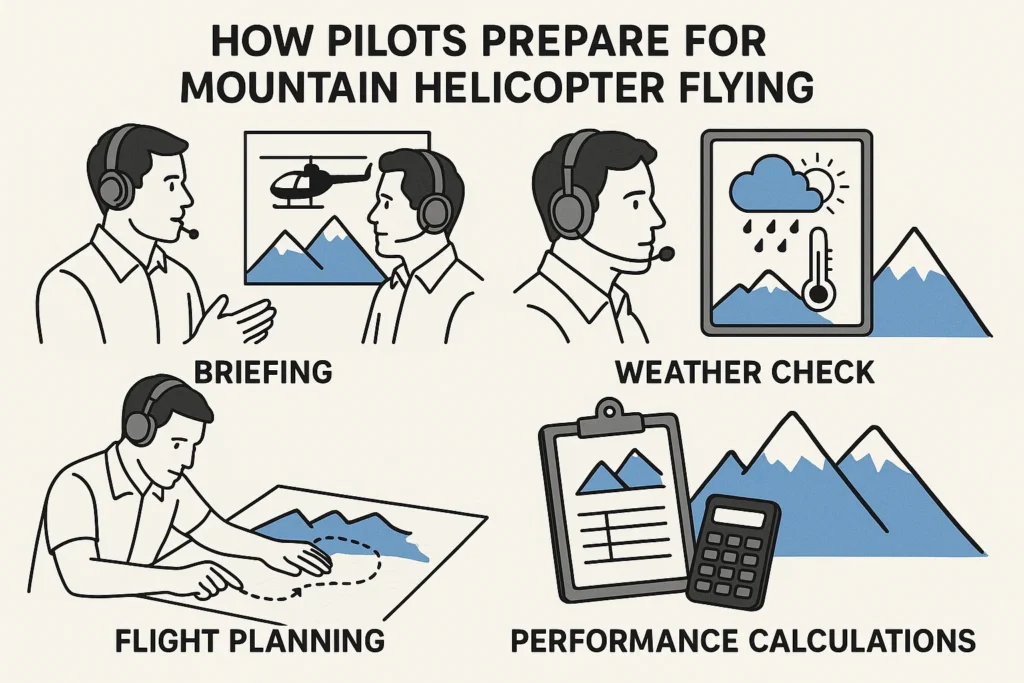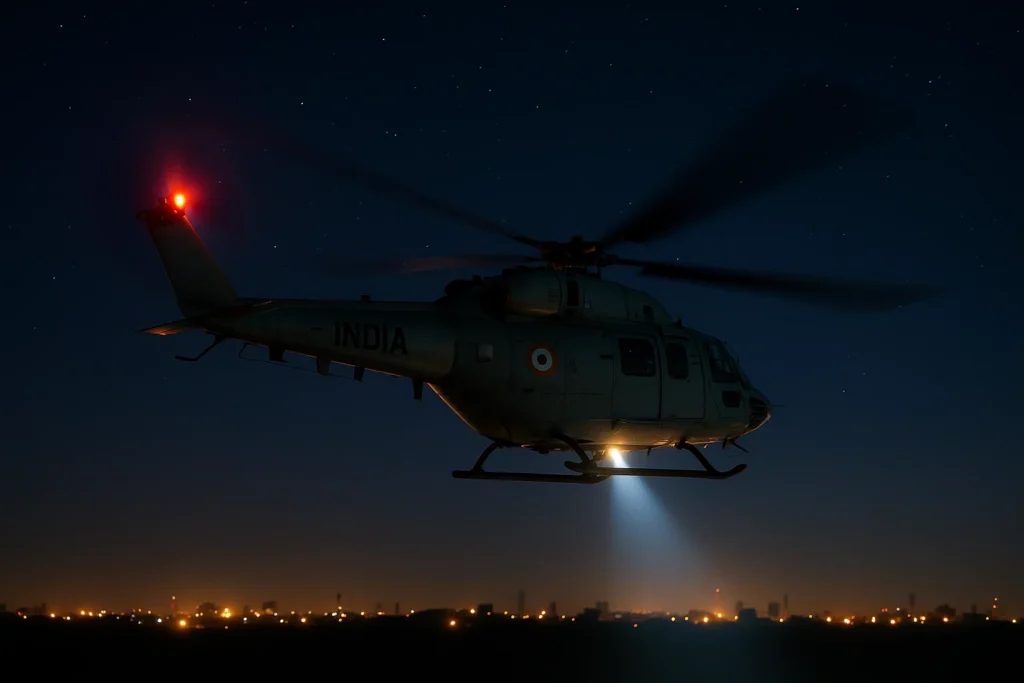✨ Introduction: How Pilots Prepare for Mountain Helicopter Flying
Mountainous terrain poses unique challenges for helicopter pilots, requiring specialized skills, training, and careful preparation. Flying in high-altitude areas with turbulent winds, narrow valleys, and unpredictable weather conditions demands both technical expertise and awareness of the environment.
In this blog post, we’ll discuss how helicopter pilots prepare for mountain helicopter flying, the specific techniques they use to navigate difficult landscapes, and the safety measures they follow to ensure both the pilot and passengers are safe during the flight.
🌍 Key Challenges of Mountain Helicopter Flying
🚁 1. High Altitude Conditions
-
Reduced Air Density: At higher altitudes, air density decreases, which means the helicopter’s rotor blades don’t generate as much lift. This requires the pilot to adjust the pitch of the blades and the engine power to compensate for the reduced lift.
-
Engine Performance: Helicopter engines perform less efficiently at higher altitudes. Pilots must monitor engine parameters carefully to prevent overheating or engine stress.
🏔️ 2. Variable Weather
-
Rapid Weather Changes: Mountainous areas are prone to sudden weather changes, including storm fronts, wind gusts, and low visibility. Pilots must be prepared to adapt quickly to these changes, sometimes altering flight paths or seeking alternate landing zones.
-
Mountain Winds: Winds can be stronger and more turbulent in mountain areas. Updrafts and downdrafts can make hovering and landing more challenging. Pilots need to anticipate and compensate for these wind conditions.
🚁 3. Navigational Challenges
-
Limited Visibility: Mountains can create narrow corridors for flight, reducing visibility and increasing the risk of collisions. Low cloud cover and fog are common in mountainous regions, requiring precise navigation.
-
Remote Landing Zones: Helicopter pilots often fly to areas with limited or no pre-existing landing zones. Pilots must identify suitable landing areas in rugged terrain, often relying on terrain-following radar and aerial reconnaissance.
🌍 How Pilots Prepare for Mountain Helicopter Flying
🚁 1. Specialized Mountain Flight Training
Flying in mountainous terrain is very different from flying in flat landscapes. Helicopter pilots must undergo specialized training to handle the unique challenges posed by mountains, including:
-
Mountain Terrain Flight Training: Pilots learn to navigate narrow valleys, windy ridges, and high-altitude areas. Training also includes the ability to perform low-level maneuvers to avoid obstacles and optimize rotor efficiency.
-
Emergency Procedures: Pilots are trained to handle emergency situations specific to mountain flying, such as engine failure, power loss, or forced landings in remote areas. They also learn how to handle autorotation (the process of gliding without engine power) in mountain conditions.
🚁 2. Pre-Flight Preparations
Before embarking on a mountain helicopter flight, pilots perform several critical pre-flight tasks:
-
Weather Assessment: Pilots check weather forecasts and real-time updates from weather stations and satellite systems to understand wind patterns, cloud formations, and temperature variations at high altitudes. They ensure that the weather is suitable for safe flight.
-
Flight Plan Review: Pilots prepare a detailed flight plan that includes altitude adjustments, flight paths, and alternate landing zones in case of emergencies. They identify potential areas for safe landing in case of mechanical failure or bad weather.
-
Weight and Balance Calculations: The helicopter’s weight and balance are crucial for safe flying in mountainous areas. Pilots calculate the total weight of the passengers, cargo, and fuel to ensure the helicopter operates within its optimal limits.
🏔️ 3. In-Flight Adjustments
During the flight, pilots must make constant adjustments to ensure a safe journey:
-
Adjusting to Weather: Pilots constantly monitor wind speed, altitude, and temperature during the flight. They may need to alter course to avoid strong gusts or turbulent zones.
-
Hovering and Landing Techniques: When landing in mountainous terrain, pilots often use techniques like crabbing (flying at an angle into the wind) or sliding into the landing area to ensure a stable approach. They also use terrain awareness to identify safe landing zones.
-
Energy Management: Flying in mountains can tax the engine, so pilots must manage the helicopter’s energy resources efficiently. This means carefully controlling the rotor speed, engine temperature, and fuel consumption.
🚁 4. Post-Flight Safety and Maintenance
After completing the mountain flight, pilots ensure the helicopter is safe for the next journey:
-
Post-Flight Inspection: Helicopters used in mountain terrain are subject to more wear and tear due to the harsh conditions. Pilots conduct thorough post-flight inspections of the helicopter’s rotors, engine, and landing gear to check for any issues caused by turbulence or high-altitude stress.
-
Maintenance Logs: All flight details, including weather conditions, flight path, and fuel usage, are logged for future reference and maintenance planning. Regular maintenance ensures that the helicopter remains in top condition for future flights.
🌍 Safety Protocols for Mountain Helicopter Flights
Pilots also follow strict safety protocols to ensure the safety of the helicopter, passengers, and crew:
-
Use of Navigation Aids: Pilots use advanced GPS and terrain-following radar systems to ensure they stay on course and avoid dangerous terrain, especially in areas with low visibility.
-
Constant Communication: Pilots maintain constant communication with air traffic control or base operations to provide updates on the flight and receive any changes in weather conditions.
-
Risk Management: Helicopter pilots are trained to anticipate risks like mountain wind shear, turbulence, and sudden altitude changes to ensure safe flight in challenging environments.
🌍 Conclusion: The Art of Mountain Helicopter Flying
Mountain helicopter flying requires a unique set of skills, preparations, and equipment. From specialized training to careful flight planning, pilots must be ready to tackle the challenges posed by mountainous landscapes, variable weather, and high-altitude conditions.
At DreamSafar, we ensure that our pilots are highly trained to handle mountain flights with precision, safety, and expertise, allowing you to experience the thrill of flying over some of India’s most beautiful and remote regions.
Whether you’re taking a scenic flight or embarking on a pilgrimage to remote mountain destinations, you can trust DreamSafar for a safe and memorable aerial adventure.
🔗 Useful Links:
Resources:
❓ FAQ Section:
Q1: Do pilots need special training for mountain helicopter flying?
A1: Yes, pilots undergo specialized training for mountain helicopter flying, which includes learning to navigate high altitudes, manage turbulent weather, and perform emergency landings in rugged terrain.
Q2: How do weather conditions affect mountain helicopter flights?
A2: Weather conditions like strong winds, turbulence, and low visibility can make mountain flying more challenging. Pilots carefully assess weather conditions before and during flights to ensure safe operations.
Q3: What makes helicopter flying in mountainous regions different?
A3: Mountain flying is unique due to factors like reduced air density, strong winds, rough terrain, and high-altitude conditions, all of which require pilots to adjust their flight techniques and safety protocols accordingly.


